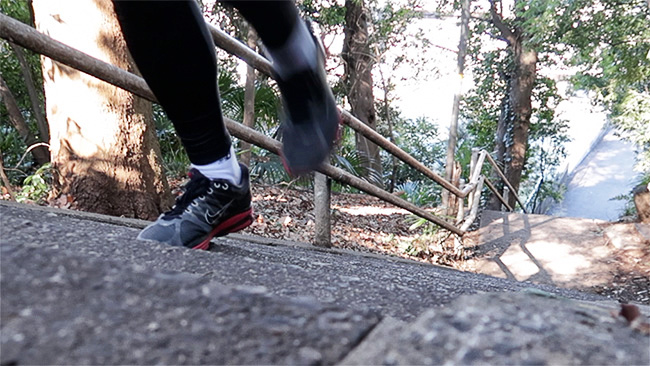There is a place nearby with 66 steps.

In early October last year, I was able to run up and down 30 times without puking. In late December, I only managed 16.
“What does this have to do with photography?” you might be wondering. A lot, actually.
I was traveling from early October through mid-December. During that time, I wasn’t for the most part able to monitor or control my diet, nor was I able to exercise much.
The stairs are important, because they are an objective benchmark and measure of my current state of fitness.
Here is what my recent experience with the stairs has looked like (note: I do other workouts in between, hence the gaps):
- 18 Dec: 16x
- 24 Dec: 21x
- 29 Dec: 26x
- 4 Jan: 30x
- 10 Jan: 30x
- 18 Jan: 15x
On a positive note, I worked my way back up to 30x within a couple of weeks or so, even with the New Year holiday and cold weather factored in.
You’ll undoubtedly see the drop back to 15x on 18 January. It was the after-effect of a week-long trip to Amsterdam for the World Press Photo judging. I was still feeling the jet-lag and general travel exhaustion on the 18th.
It snowed heavily shortly thereafter, so it hasn’t been safe to go back to the stairs.
My reason for writing this is to highlight the concept of objectivity.
Stairs do not lie. They do not tell you are awesome because they want you to like them. They do not cut you slack because you’re feeling down. Whether I manage 15x or 30x, the stairs are a constant, so the primary variable is me.
I bring this up in the context of photography because I’ve had a bit of time to think after my experience at World Press. I am also contemplating my philosophy and responsibilities for participating as one of the seven judges for this year’s Big Picture Natural World Photography Competition (enter by 1 March!)
Photography is tricky. Technical proficiency is required. You can’t produce nice photos in a consistent manner if you don’t know how light and photo gear work.
But at the same time, there is a subjective element, the X-factor that transforms a holiday snapshot into a transfixing work of art.
It is therefore difficult to argue that judging of photo contests is objective. I don’t think it is.
But—and this is a huge but—objectivity is critical, because what became obvious from going through nearly 10,000 images with my fellow judges at World Press, was that it was pretty easy to separate the contenders from the submissions that didn’t measure up.
In other words, at some fundamental level, there is the equivalent of a stairway of 66 steps, against which you can measure your photos and progress as a photographer.
What I’m trying to say is that if you want to improve your images, irrespective of whether you want to enter photo contests or not, measure your output and progress not by Likes and Hearts and such, but by objective standards.
It is certainly not easy to do this with a pursuit that incorporates a substantial element of subjectivity. But measuring your work and progress in a non-personal way is definitely possible.
My own 66 steps in this sense are a handful of people that I trust to tell me flat out if something I’ve produced and think is great actually falls flat and is uninspiring.
I rely on people who are qualified to tell me what they think. Some of them have a solid grasp of photography, visual art, nature. Others have a great sense of aesthetics. In all cases, I trust them to provide honest feedback, and I never take it personally.
In the long run, objectivity is the best measure of progress and the best way to progress.